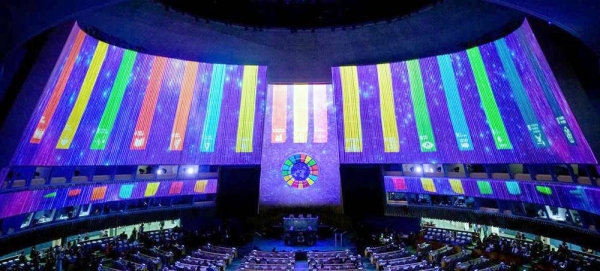
It is hard to imagine any more devastating effects of climate change than the fires that have been raging in California, Oregon and Washington, or the procession of hurricanes that have approached — and, at times, ravaged — the US’ Gulf Coast. There have also been deadly heat waves in Pakistan and Europe, and devastating flooding in Southeast Asia. But there is far worse ahead, with one risk in particular so great that it alone threatens humanity itself: The rapid depletion of Arctic sea ice.
Recalling an Alfred Hitchcock movie, this climate “bomb” — which could more than double the rate of global warming — has a timer that is being watched with growing anxiety. Each September, the extent of Arctic sea ice reaches its lowest level before the lengthening darkness and falling temperatures cause it to begin to expand again. At this point, scientists compare its extent to previous years.
The results should frighten us all. This year, measurements from the National Snow and Ice Data Center in Boulder, Colorado, show that there is less ice in the middle of the Arctic than ever before, while just-published research shows that winter sea ice in the Arctic’s Bering Sea hit its lowest level in 5,500 years in 2018 and 2019.
Over the entire Arctic, sea ice reached its second-lowest extent ever on Sept. 15. Amounts vary from year to year, but the trend is inexorably downward: The 14 Septembers with the least sea ice have all been in the last 14 years.
But sea ice is not only covering a smaller area; it is also thinner than ever. The oldest sea ice (more than four years old), which is more resistant to melting, now comprises less than 1 percent of all sea ice cover. First-year ice now dominates, leaving the sea cover more fragile and quicker to melt. Scientists now think the Arctic Ocean could be almost ice-free in late summer within a decade or two.
The effects would be catastrophic. In the extreme scenario, which could happen within decades, loss of all ice during the entirety of the sunlit months would produce global radiative heating equivalent to adding 1 trillion tons of carbon dioxide to the atmosphere. To put this into perspective, in the 270 years since the Industrial Revolution began, 2.4 trillion tons of carbon dioxide have been added to the atmosphere. About 30 percent of the Arctic warming has already been added to the climate because of the ice lost between 1979 and 2016, and more warming follows quickly as more of the remaining ice is lost.
This extreme scenario would drive climate change forward by 25 years, and it is hardly far-fetched. Just last month, a block of ice about twice the size of Manhattan broke off from the largest remaining Arctic ice shelf, in Northeast Greenland, after record summer temperatures.
Meanwhile, on land, the Greenland ice sheet is also in peril. With Arctic warming occurring at least twice as fast as average global warming, Greenland’s rate of melting has at least tripled over the last two decades. It is believed that this will become irreversible in a decade or even sooner. Eventually, this melting will cause sea levels to rise by up to 7 meters, drowning coastal cities, though this peak will most likely not be reached for hundreds of years.
Urgent action is needed to mitigate the tremendous — even existential — risks humanity is facing.
Mario Molina & Durwood Zaelke
Compounding the problem of accelerating Arctic warming is the self-reinforcing feedback risk of permafrost thawing. With about twice as much carbon locked away in permafrost as is already in the atmosphere, releasing even some of it could be disastrous. Permafrost thawing would also release even more potent greenhouse gases: Nitrous oxide and methane. As global temperatures rise, it is also possible that even more methane could be emitted from the East Siberian Arctic Shelf’s shallow seabed.
Clearly, urgent action is needed to mitigate these tremendous — even existential — risks. Rapidly reducing carbon dioxide emissions is necessary, but not nearly sufficient. In fact, studies show that even rapid cuts in carbon dioxide would mitigate only about 0.1 to 0.3 degrees Celsius of carbon dioxide warming by 2050.
That is why it is also vital to slash emissions of so-called short-lived climate pollutants: Methane, black carbon, hydrofluorocarbons (HFCs), and tropospheric ozone. Such action could mitigate six times as much warming as reductions in carbon dioxide emissions by 2050. Overall, eliminating emissions of these super pollutants would halve the rate of overall global warming and reduce projected Arctic warming by two thirds.
Some progress is being made. Almost four years ago, in Kigali, Rwanda, 197 countries adopted an amendment to the Montreal Protocol focused on phasing out HFCs. Already, the Montreal Protocol has facilitated the phase-out of nearly 100 chemicals that fuel global warming and endanger the ozone layer.
Moreover, in the US, the Senate last month reached a bipartisan deal to cut the production and importation of HFCs by 85 percent by 2036. California, for its part, has slashed black carbon emissions by 90 percent since the 1960s, and will halve the remainder by 2030. And the US Climate Alliance — a bipartisan group of 25 state governors — has set the goal of reducing methane emissions by 40 to 50 percent by 2030.
These are laudable goals. But reaching them, let alone the more ambitious targets needed to stem the rise in global temperature, will require us to overcome strong headwinds.
• Mario Molina, a 1995 Nobel laureate in chemistry, was a professor at the University of California, San Diego, and the National Autonomous University of Mexico.
• Durwood Zaelke is President of the Institute for Governance & Sustainable Development and a co-director of the Program on Governance for Sustainable Development at the University of California, Santa Barbara.
©Project Syndicate
Disclaimer: Views expressed by writers in this section are their own and do not necessarily reflect Arab News" point-of-view












